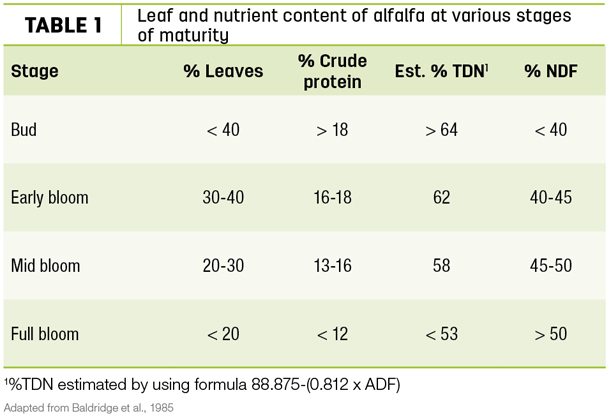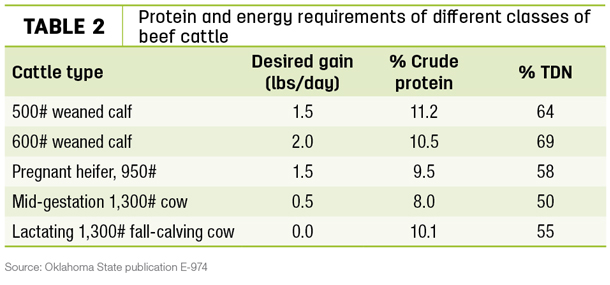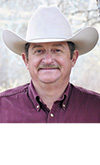Weaned, vaccinated calves continue to bring a premium, and most value-added programs want calves that have been weaned a minimum of 30 to 45 days.
In many areas of North America, obtaining an extra cutting of alfalfa hay is limited by environmental conditions, yield or hay value. Grazing the last cutting of alfalfa or alfalfa aftermath allows for extending the grazing season and provides high-quality feed for cattle.
In addition, grazing reduces feed costs by eliminating labor and machinery associated with harvesting and feeding. However, proper management is needed to prevent stand damage or animal health issues.
Proper timing
After a hay cutting, it takes alfalfa plants four to six weeks to recover carbohydrate stores in the crown of the plant. These carbohydrate stores are needed to produce the next cutting of hay during the growing season or to allow the plant to overwinter and resume growth the next spring.
During the regrowth phase, the alfalfa plant depletes a majority of its carbohydrate stores in the first two weeks. Therefore, it is important that grazing is timed:
- After carbohydrate stores have been replenished
- When the plant is dormant or will shortly become dormant
- With ground conditions that are dry enough or frozen to prevent damage to soil or alfalfa plant crowns
Grazing immediately before or several days after a killing frost is a good strategy in colder areas of the U.S. In warmer areas, producers need to know the dormancy rating of the variety planted as well as when day-length conditions result in dormancy.
Ranchers should contact local extension professionals or crop consultants for information on dormancy for a particular variety.
When timing recommendations are followed, the potential damage to the stand by grazing is reduced. Varieties are available that were selected for grazing tolerance and should be used for planned grazing (National Alfalfa & Forage Alliance).
Many producers prefer to graze older alfalfa stands that are already reduced in yield or are becoming mixed grass-alfalfa stands. In our area of the West, an important timing issue is to initiate grazing early enough in the fall to reduce damage to alfalfa from elk.
Grazing management
Grazing the last cutting of alfalfa after dormancy may result in decreased overwintering of alfalfa weevil eggs and decrease weevil pressure the following spring. In addition, fall grazing of alfalfa decreased verticillium wilt and crown rot in infected fields.
Grazing reduces cover and allows predators to reduce the rodent population. Reported grazing impacts on subsequent yield varied from no effect to a 9 percent decrease.
Grazing management needs to focus on several important aspects.
- Minimizing impact on the stand
- Maximizing utilization
- Optimizing animal performance
Uncontrolled grazing of alfalfa stands results in poor utilization and potential stand damage. Short-duration grazing such as strip grazing is recommended. Swath grazing combined with limiting access to portions of the field is also effective. Allocating three to five days’ feed at a time reduces trampling and potential damage to the stand.
Swathing alfalfa immediately before or after frost can preserve forage quality, reduce trampling and minimize leaf shatter. If windrows are extremely light, it may help to merge windrows.
However, excessively heavy windrows that are not fully grazed can result in stand damage. Efforts should be made to utilize all windrows before late winter. Research indicates that crude protein and total digestible nutrients are only decreased by 2 to 3 percent after several months into the winter.
Access to water during the late fall and early winter is always problematic, especially with strip grazing. If animals must cross previously grazed areas of the field, it is best to create a travel alley to water.
This sacrifices a small portion of the stand and eliminates animals continuing to walk on already grazed portions of the stand.
Animal selection and performance
Because fall-grazed alfalfa is high in both protein and energy (Table 1), it is best utilized by classes of cattle with high nutrient requirements (Table 2).


Most alfalfa swathed for fall grazing will be cut in the bud to early bloom stage. By comparing Tables 1 and 2, notice that alfalfa cut in these two early stages will meet or exceed requirements for most classes of beef cattle.
Weaned backgrounded calves, yearling replacement heifers and fall-calving cows are good candidates for utilization of this forage. In addition, limit-grazed alfalfa can be used as protein supplement for dry spring-calving cows being fed crop residues.
Little data exists on the quality decline of swathed alfalfa as the fall and winter progress. Leaf shatter and trampling by cattle probably have the greatest negative effect on quality.
Areas of the country with high fall moisture levels and above-freezing temperatures may also see a greater decline in alfalfa quality during the grazing period.
Making bigger windrows and strip grazing will help ensure quality. Another strategy is to place young high-nutrient-need cattle on the field first and then follow with mature cows to clean up the field.
At the University of Idaho Nancy M. Cummings Research, Extension and Education Center, we have a 100- to 120-day growing season followed by cold damp falls with limited drying time during the day. For over 10 years, grazing weaned calves on alfalfa has been part of the management system. We make two hay cuttings followed by grazing of the third crop.
Initially, calves were strip grazed on standing alfalfa with cattle introduced one to two weeks following a killing frost. Despite using self-fed blocks containing poloxalene (Bloat Guard), several calves per year were lost to bloat.
In the past four years, the management strategy switched to strip grazing swathed alfalfa, and calves have been provided bloat prevention and minerals as a self-fed liquid supplement.
Since switching management, we lost no calves to bloat. However, it is difficult to determine if all the effect can be ascribed to the supplement or swathing. Since 2008, performance of weaned calves on fall-grazed alfalfa has varied from 1.2 to 1.7 pounds per day.
Bloat prevention
Waiting to graze alfalfa until after frost or after swathing can reduce the incidence of bloat. However, in both cases, plants will need at least a week to dry in order to reduce bloat potential. Immediately after frost, cell rupture due to freezing will actually increase the bloating potential of alfalfa.
Ensuring cattle are full before introduction to alfalfa will decrease rate of intake and reduce bloat. Also waiting until the dew dries off the field before moving cattle onto alfalfa or to a new strip will decrease incidence of bloat.
Allowing cattle access to poloxalene (Bloat Guard) either in block form or as part of a liquid feed can reduce bloat. As a consistent intake is essential, liquid supplements or hand-fed supplements may improve efficacy.
Surfactants or anti-foaming agents can have beneficial effects as well. Make sure, before they are included in supplements, that they are approved and demonstrated effective based on unbiased research. ![]()
References omitted but are available upon request. Click here to email an editor.
PHOTO: Because fall-grazed alfalfa is high in both protein and energy, it can be used by cattle with high nutrient needs. Staff photo.

-
John B. Hall
- Extension Beef Specialist
- University of Idaho
- Email John B. Hall







